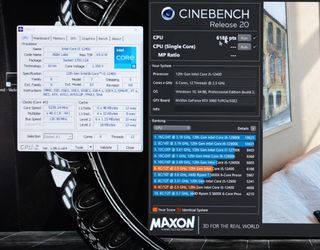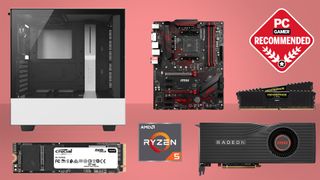Real CPU overclocking is possible on Non-K Alder Lake CPUs
OC a budget CPU to flagship tier performance levels? Yes please!
Intel’s 65W 12th Gen CPUs are trickling into the market. They offer good value, and in particular they make strong gaming CPUs due to the impressive clock for clock performance of the Golden Cove P cores. Sadly, all non-K CPUs have locked clock multipliers, so cheap models like a 12400 or 12500 cannot be overclocked to any meaningful degree. Or can they? According to well known overclocker Der8auer, locked 12th Gen CPUs can indeed be overclocked. And not by a little, but by a lot, though there are some caveats.
This isn’t a simple power limit tweak, but an actual overclock that takes a CPU like the i5 12400 and increases its clock speed from its default 4.4GHz maximum turbo speed to over 5.2GHz. This elevates a cheap CPU to i7 or i9 levels of gaming performance. Der8auer also tried this with the i5 12600 and achieved a slightly less impressive but still notable 5.1GHz all core OC.

According to Der8auer, certain Asus motherboards have a base clock OC option when a locked 65W CPU is installed. The ‘Unlock BLCK OC’ option appears in the Tweakers Paradise submenu of the BIOS of the Asus ROG Z690 Maximus Apex. The user can then modify the clock speed of the CPU, in this case, by a bit over 130MHz. This delivers an OC of over 5.2GHz with the 40X CPU multiplier of the 12400. Increasing the BCLK affects the RAM and cache speeds, so these will need to be multiplier adjusted to keep them functioning.
Once that's done, it's a simple matter of adjusting the CPU voltage and monitoring cooling as you would with any other CPU OC. Der8auer ran some benchmarks which showed the 12400 delivering a 33% gain in Cinebench, along with some impressive gaming improvements.

Best CPU for gaming: the top chips from Intel and AMD
Best graphics card: your perfect pixel-pusher awaits
Best SSD for gaming: get into the game ahead of the rest
Sadly, the option appears to be limited to motherboards that feature an external clock generator, so the dream of taking a low end board and using it to overclock a cheap CPU to 5GHz+ appears to be impossible, at least for now.
An external clock generator allows the base clock to be decoupled from other bus clocks that are derived from the base clock. In years past, base clock overclocking meant that PCIe and SATA devices would cease functioning if the base clock was increased by more than a couple of percent. An external clock generator appears to get around this limitation, but it requires additional components and engineering, which would explain why it isn’t found on entry level boards.
We can expect overclockers to get to work in the days ahead and report their findings, as well as check if other motherboards will allow base clock overclocking. There’s also the possibility that Intel will come over the top and order motherboard manufacturers to remove these options.
Whatever the case, if Intel allows this to continue and it's found to work on some affordable motherboards, this could lead to a resurgence in overclocking, which has taken a back seat in recent years due to limited overhead. A 1GHz+ overclock is well worth it.
PC Gamer Newsletter
Sign up to get the best content of the week, and great gaming deals, as picked by the editors.

Chris' gaming experiences go back to the mid-nineties when he conned his parents into buying an 'educational PC' that was conveniently overpowered to play Doom and Tie Fighter. He developed a love of extreme overclocking that destroyed his savings despite the cheaper hardware on offer via his job at a PC store. To afford more LN2 he began moonlighting as a reviewer for VR-Zone before jumping the fence to work for MSI Australia. Since then, he's gone back to journalism, enthusiastically reviewing the latest and greatest components for PC & Tech Authority, PC Powerplay and currently Australian Personal Computer magazine and PC Gamer. Chris still puts far too many hours into Borderlands 3, always striving to become a more efficient killer.
Most Popular



